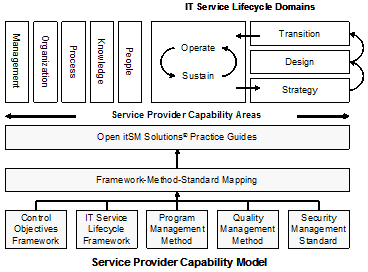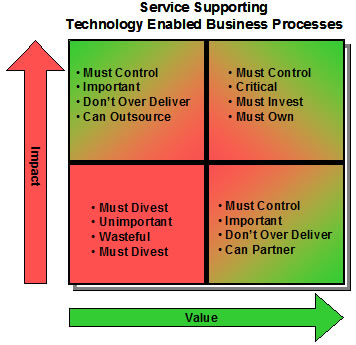These changes have both internal and external drivers, and these drivers have combined into a near "perfect storm." The first ingredient to the perfect storm is rapid commoditization of technology. The second is the widespread availability of alternatives to internal IT services. Third is the demand for measurable value from any IT service - internal or externally provided.
The result is increasing IT complexity and fragility as many IT organizations today focus on "keeping the technology lights on" as opposed to delivering the value that technology can bring to the enterprise.
A recent Gartner report predicts that over the next five years IT will become integrated into the enterprise or mission value network. Senior non-IT leaders will manage based on value and risk, not IT costs as they do today. In response, IT will shift its focus from the internal delivery of technology ("keeping the lights on") to brokering services in a multi-source environment. In effect, IT will become an "internal service provider."
Regardless of the recipe, the convergence of forces is creating an environment that forces IT to change how it operates. In my experience, what follows represents the characteristics that organizations adapting to today's changing "business technology ecosystem" must develop.
The Internal Outsourcer - The "internal outsourcer" is a reference model. It is an abstract representation of the entities and relationships involved in the IT Service Management problem space. It forms the conceptual basis for the development of more concrete models in this space and serves as an abstract template for the development of more specific models in this domain, and allows for comparison of different models. In other words, it gives us a simple way to think about a very complex problem.
It also supports a generic Service Provider capability model that enables adopting IT organizations to clearly identify where they sit from a capability standpoint and to have a clearly defined "desired end-state" to work toward. The capability model subsequently supports IT organizational transformation efforts and its adoption of the IT Service Lifecycle approach to create and capture service value. It also supports the development of the organizational capability to provide these services in a multi-source environment.

Characteristics of an Internal Outsourcer - Any organization transforming from a technology provider to a service provider focus will adopt the following characteristics.
Value Focus - Evolving Business Technology Organizations (BTOs) will shift their focus from providing technology to the creation and capture of service value. This concept is fundamental in the ITIL's Service Strategy domain volume. Value is the combined perception by the business of a service's utility (fit for purpose) and its warranty (fit for use) in the support of its processes. Value is created through the understanding of the business' needs and providing services that meet their expectations. Value is captured through the achievement of desired business outcomes.
In practical terms, frameworks such as CobiT provide guidance on IT governance and ITIL on how to achieve it with process workflow. A value focus is a management and organizational capability that can be developed through managing IT Services through the IT Service Lifecycle.
Value Network - A value network is a way of representing a complex set of relationships within an enterprise, and specifically within a BTO. Due to the ubiquitous nature of technology and the emergence of external service providers today's "internal outsourcer" must understand, leverage and manage these complex relationships. The days of providing all IT Services internally are long gone. As IT organizations transform (evolve) to BTOs, sourcing decisions are going to be more critical as is managing the customer and the service provider (both internal & external).
The practical implications of the BTO becoming integrated into the enterprise value network impacts the entire IT Service Lifecycle. Service Strategy must take into consideration the market space being served and the value and impact of the service considered for deployment. Service Design must apply the design criteria in making the decision to in source or outsource the service. Service Transition executes the design and deals with the integration of new or improved services into the production environment. Service Operation deals with day-to-day issues of the delivery and support of production services and as such is integral to the management of the relationships within the value network.
Simplification - IT infrastructures are orders of magnitude more complex than they were just five years ago. Many enterprises are supported by a myriad of legacy applications, running on a conglomeration of disparate technology architectures. This is further complicated by the evolution of the "global" enterprise, which further disperses both the infrastructure and significantly complicates its management. As new technology emerges and as more and more external service providers are introducing services based on newer technology, today's IT organizations find it very difficult to adopt and leverage external services without a significant (and costly) re-architecting of their existing infrastructure.
This is a manifestation of two generations of technological focus. The practical aspects of this situation demand that the "internal outsourcer" aggressively evaluate its current architecture and focus on its simplification (removal or elimination of complexity). Trends in technology with significant potential in delivering "utility grade" computing such as a Service Oriented Architecture (SOA) and Real Time Infrastructure (RTI) are providing the drivers for infrastructure simplification.
Sourcing - In the past, the prevalent reason for outsourcing IT services was to reduce the cost of those services. Over the years the technology and financial trade press has been full of horror stories of outsourcing relationships gone bad and the subsequent trend of "in sourcing." There are two major reasons for failed outsourcing relationships; failure to achieve anticipated cost savings and lack of demonstrated flexibility and agility by the outsourcer to changing business needs. The former is often the result of not having complete control of the processes and services outsourced and the latter is symptomatic of the failure to understand the value and impact of the services outsourced.
CobiT and the ITIL's v3's guidance brings a more mature approach to how an enterprise (note the use of the term enterprise, not IT or BTO) can make rational sourcing decisions and thus avoid the two major causes for outsourcing failure. The "internal outsourcer" is an organization that takes into consideration both the value of the services being provided as well as its impact to the business and makes its sourcing decisions accordingly.

This approach evaluates both the value (perceived utility & warranty) of a service to its demonstrated impact (influence on the achievement of desired business outcomes). The figure above illustrates how value and impact help shape sourcing decisions.
Capabilities - The "internal outsourcer" must develop and mature a set of capabilities that enable it to create and capture the value of services provided to the enterprise. Capabilities are a specialized set of assets used to turn assets into services. Inherent in this is the drive for the optimization of those resources, irrespective of their source.
- Management
- Organization
- Process
- Knowledge
- People
ITIL's v3 guidance in this area is a bit academic and does not necessarily represent a set of "best practices. However, it does provide the basic principles that the "internal outsourcer" must internalize if they are to be successful in their transformation. A more comprehensive set of guidance is Carnegie Melon's eSourcing Capability Model (eSCM) for Service Providers. While intended for external service provider organizations it represents a more rational model of a "service provider" and the capabilities required to be successful.
Summary
While the various frameworks, methodologies and standards that attempt to provide guidance and support to IT Service Management offer little in the way of a "prescription," and for good reason. Each organization faces a different set of challenges and each framework, methodology and standard can and must be crafted to meet those challenges. Organizations that are seeking to transform themselves into an "internal outsourcer" must seek out that prescription from within the guidance available. Failure to adapt to the changing business and technological ecosystem has dire consequences for the enterprise, IT and the IT professional.